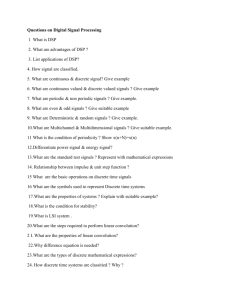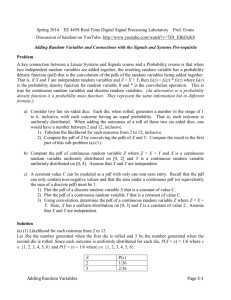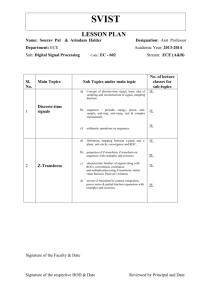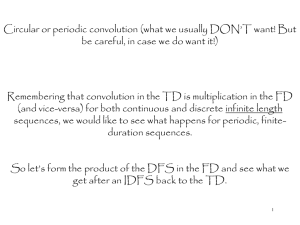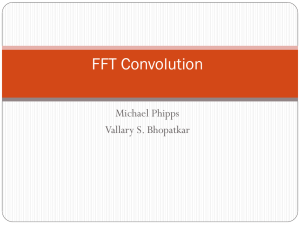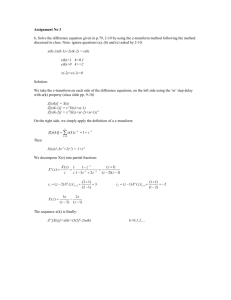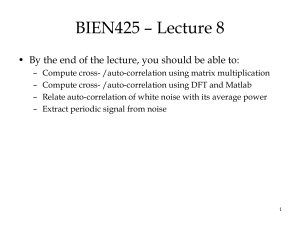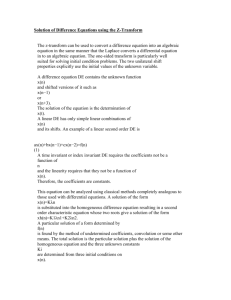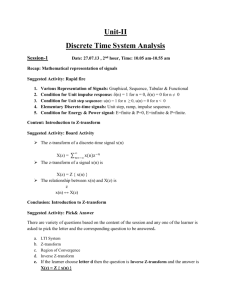DSP-UNIT-I - VRS College of Engineering & Technology
advertisement
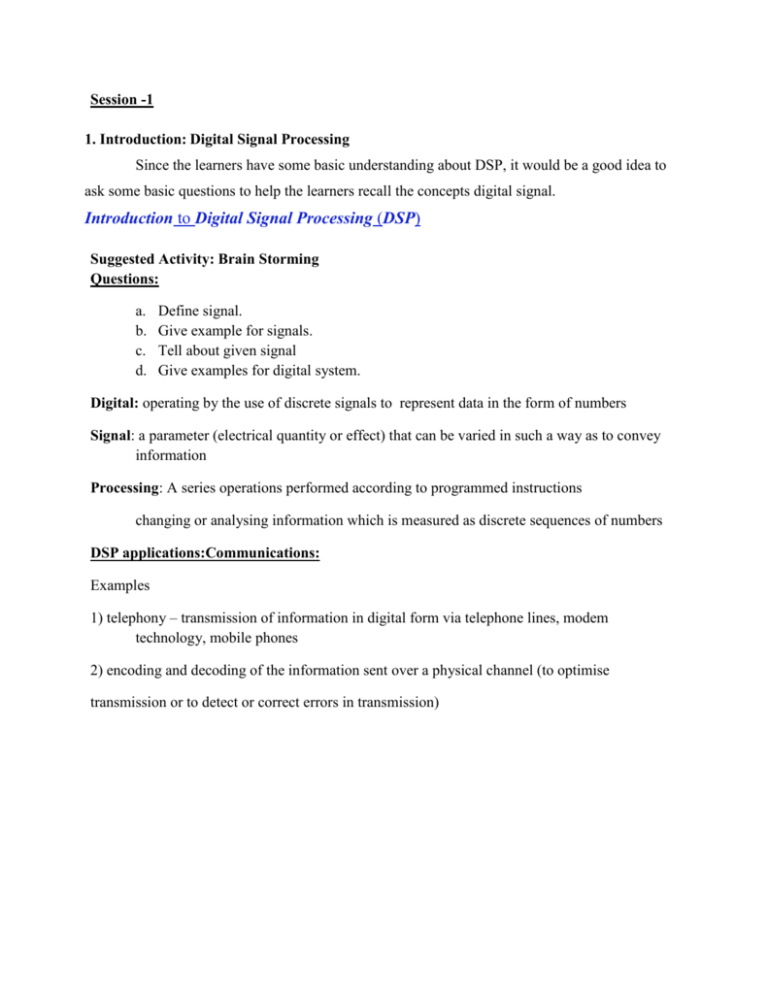
Session -1
1. Introduction: Digital Signal Processing
Since the learners have some basic understanding about DSP, it would be a good idea to
ask some basic questions to help the learners recall the concepts digital signal.
Introduction to Digital Signal Processing (DSP)
Suggested Activity: Brain Storming
Questions:
a.
b.
c.
d.
Define signal.
Give example for signals.
Tell about given signal
Give examples for digital system.
Digital: operating by the use of discrete signals to represent data in the form of numbers
Signal: a parameter (electrical quantity or effect) that can be varied in such a way as to convey
information
Processing: A series operations performed according to programmed instructions
changing or analysing information which is measured as discrete sequences of numbers
DSP applications:Communications:
Examples
1) telephony – transmission of information in digital form via telephone lines, modem
technology, mobile phones
2) encoding and decoding of the information sent over a physical channel (to optimise
transmission or to detect or correct errors in transmission)
2. Basic elements of digital signal processing
Basic block diagram of a DSP
Advantages of digital over analog signal processing
We can discuss about the elements of DSP through presentation
Suggested Activity: Presentation
Through PPT explain DSP block diagram and advantages.
3. Conclusion –Mind map &Board activity
a. Give components present in DSP block diagram.
b. Draw the block diagram of DSP.
c. Tell about ADC and DAC.
Session -2
1. Recap : DSP
Suggested Activity: Quiz
We can conduct a quiz to check the learners what things they learned in previous
session.
2. Derivation of frequency in analog signal
Suggested Activity: chalk and talk
3. Derivation of frequency in digital signal - board activity
4. Conclusion- Recall by words.
Words: analog, digital, frequency, Euler’s identity, x (t), and x[n]
Session-3
1. Introduction –Sampling
Suggested Activity: Introduces
Nyquist–Shannon sampling theorem - Wikipedia, the free ...
We can introduce about sampling with examples
A sufficient condition to reconstruct x(t) from its samples is
equivalently
The two thresholds,
and
and
are respectively called the Nyquist
rate and Nyquist frequency. And respectively, they are attributes of x(t) and of the sampling
equipment. The condition described by these inequalities is called the Nyquist criterion, or
sometimes the Raabe condition. The theorem is also applicable to functions of other domains,
such as space, in the case of a digitized image. The only change, in the case of other domains, is
the units of measure applied to t, T, f, fs, and B.
2. Sampling theorem
Suggested Activity: chalk and talk
We can discuss the sampling theorem
3. Proof of sampling theorem, aliasing and nyquist theorem
Suggested Activity: chalk and talk
4. Conclusion& summary
Suggested Activity: Match word puzzle
Fs >= 2W
Sampling
Analog to digital conversion
Nyquist rate
Fs = 2W
Sampling theorem
Fs < 2W
Aliasing
Session-4
1. Introduction-Signals
Suggested Activity: Questions and answers
Sample questions:
1. What is a signal?
2. What are the different types of signals?
3. What are the signals that we encounter in daily life?
4. What are different ways in which the signals can be classified?
5. What are the mathematical tools used to represent a signal in frequency domain?
2. Discrete time signals
Discrete signal - Wikipedia, the free encyclopedia
Suggested Activity: -chalk and talk
A discrete signal or discrete-time signal is a time series consisting of a sequence of
qualities. In other words, it is a type series that is a function over a domain of discrete integral.
Unlike a continuous-time signal, a discrete-time signal is not a function of a continuous
argument; however, it may have been obtained by sampling from a continuous-time signal, and
then each value in the sequence is called a sample. When a discrete-time signal obtained by
sampling a sequence corresponding to uniformly spaced times, it has an associated sampling
rate; the sampling rate is not apparent in the data sequence, and so needs to be associated as a
separate data item.
Discrete sampled signal
3. Classification
digital signal
Suggested Activity: - Odd man out
4. Conclusion
Suggested Activity: Problems
a. Draw x(n)={2,5,4,7,1}
b. Find x(n-1) for x(n) = {2,9,8,3,4}
Session-5
1. Introduction – System
Suggested Activity: Quiz
a. What is system?
b. Give examples for system.
c. Differentiate analog and digital system.
2. Discrete time systems
Suggested Activity: Chalk and talk
3. Classification
Suggested Activity: Odd man out
4. Conclusion-Match the following
Superposition principle
Stability
Output depends present
input
Need memory
Shifting
Causal
Dynamic
Linear
Invariant
Stable
Session -6
1. Recap: DT System
Suggested Activity: Recall by words
3.
1. x (n)
2. defined specific time
3. summation
4. ‘n’ integer
Analysis of LTIS
LTI system theory - Wikipedia, the free encyclopedia
en.wikipedia.org/wiki/LTI_system_theory
Suggested Activity: Writing board
Derive causality and stability condition for LTIS on board and finally ask
condition for the causality and stability to the learners for knowing the understanding of
learners.
Linear time-invariant theory, commonly known as LTI system theory, comes
from applied mathematics and has direct applications in NMR
spectroscopy, seismology, circuits, signal processing, control theory, and other technical
areas. It investigates the response of a linear and time-invariant system to an arbitrary
input signal. Trajectories of these systems are commonly measured and tracked as they
move through time (e.g., an acoustic waveform), but in applications like image
processing and field theory, the LTI systems also have trajectories in spatial dimensions.
Thus, these systems are also called linear translation-invariant to give the theory the
most general reach. In the case of generic discrete-time (i.e., sampled) systems, linear
shift-invariant is the corresponding term. A good example of LTI systems are electrical
circuits that can be made up of resistors, capacitors, and inductors.
4.
Conclusion & summary
Suggested Activity: Brain storming
1. Define LTIS.
2. Draw block diagram
3.
4.
5.
6.
What is convolution?
What are the properties of convolution?
Give condition for causality.
Give condition for stability.
Session -7
1. Recap: Z-transform
Suggested Activity: Discuss & questions
Learners have basic idea about z-transform studied in mathematics. Discuss the topic with
asking questions.
1. Define z-transform.
2. Give the formula for z-transform.
3. Find z-transform for x(n) =an u(n).
4. Give any two properties of z-transform.
2. Z-transform and ROC:
Suggested Activity: Chalk and talk
Explain z-transform, ROC and inverse z-transform on the board and also solving
problems.
3. Conclusion:
Suggested Activity: Tit for tat
Session -8
1. Recap: Z-transform
Suggested Activity: Problem solving
a. x(n) = 2n u(n) X(z) =?
b. x(n)={2,3,1,4}.Determine z-transform.
c. x(n)={7,5,9,1}Find ROC.
Z transform is the powerful tool for analyzing Linear –time invariant discrete
time systems in the frequency domain.
The frequency response of discrete time systems can be determined by
evaluating the transfer function on the unit circle of Z plane
2. Properties of z-transform
Suggested Activity: PPT and board
Through PPT explain the properties of z-transform and proof of properties on the board.
3. Conclusion
Suggested Activity: Rapid fire
Session -9
1. Introduction –Convolution
Suggested Activity: Introduces
Convolution - Wikipedia, the free encyclopedia
For the usage in formal language theory, see Convolution (computer science).
Visual comparison of convolution, cross-correlation andautocorrelation.
In mathematics and, in particular, functional analysis, convolution is amathematical operation on
two functions f and g, producing a third function that is typically viewed as a modified version of one of the original
functions, giving the area overlap between the two functions as a function of the amount that one of the original
functions is translated. Convolution is similar to cross-correlation. It has applications that
include probability, statistics,computer vision, image and signal processing, electrical engineering, anddifferential
equations.
The convolution can be defined for functions on groups other than Euclidean space. For example, periodic
functions, such as the discrete-time Fourier transform, can be defined on a circle and convolved by periodic
convolution. And discrete convolution can be defined for functions on the set of integers. Generalizations of
convolution have applications in the field of numerical analysis and numerical linear algebra, and in the design and
implementation of finite impulse response filters in signal processing.
Computing the inverse of the convolution operation is known as deconvolution.
Linear and circular convolution Suggested Activity: writing board
Linear and circular convolution are fundamentally different operations. However, there are conditions under
which linear and circular convolution are equivalent. Establishing this equivalence has important implications. For two
vectors, x and y, the circular convolution is equal to the inverse discrete Fourier transform (DFT) of the product of the
vectors' DFTs. Knowing the conditions under which linear and circular convolution are equivalent allows you to use the
DFT to efficiently compute linear convolutions.
The linear convolution of an N-point vector, x, and a L-point vector, y, has length N+L-1.
For the circular convolution of x and y to be equivalent, you must pad the vectors with zeros to length at least N+L-1 before
you take the DFT. After you invert the product of the DFTs, retain only the first N+L-1 elements.
Create two vectors, x and y, and compute the linear convolution of the two vectors.
Linear and Circular Convolution - MATLAB & Simulink - MathWorks ...
3. Conclusion
Suggested Activity: formulas and problem solving
Convolution topic is revised by using formulas and problem solving
x(n)={1,2,3,4}
h(n)={4,3,2,1} determine y(n).
